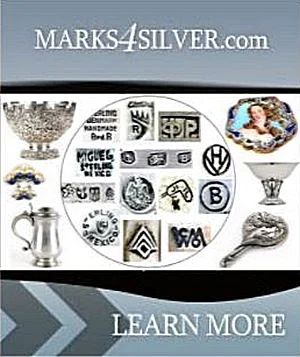Pricing Guides & Dictionary of Makers Marks for Antiques & Collectibles

A few examples of appraisal values for
GRAHAM CLARKE ETCHINGS
Search our price guide for your own treasures
-
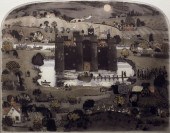 Graham Clarke (born 1941) - Limited
Graham Clarke (born 1941) - Limited edition coloured etching - ''The Goose Girl'' 21ins x 26.5ins signed titled and No. 25 of 15 in pencil to margin in silvered frame and glazed
Graham Clarke (born 1941) - Limited
Graham Clarke (born 1941) - Limited edition coloured etching - ''The Goose Girl'' 21ins x 26.5ins signed titled and No. 25 of 15 in pencil to margin in silvered frame and glazed -
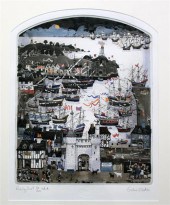 Graham Clarke (b. 1941) thirteen
Graham Clarke (b. 1941) thirteen coloured etchings with aquatint History of England Edition A signed in pencil and numbered 73/200 17 x 13.5in. Estimate ?1 000-1 500 13 prints are in the lot representing the set as catalogued these comprise: Going West 87/200 Men of Kent 175/200 Jolly Good Robin Hood 38/200 Steamers 45/200 Fire Works 83/200 Ready Sir 73/200 Albert All 145/200 Waterloo Volunteers 76/200 Romans Do 93/200 Rufus Spratling Chronicle 101/200 Good Lord 88/200 The Wooden O AP Canters Chaucebury 53/200 All in very good clean condition with cream mounts and silvered frames. Descriptions provided in both printed and on-line catalogue formats do not include condition reports. The absence of a condition statement does not imply that the lot is in perfect condition or completely free from wear and tear imperfections or the effects of aging. Interested bidders are strongly encouraged to request a condition report on any lots upon which they intend to bid prior to placing a bid. All transactions are governed by Gorringes Conditions of Sale.Sold for ?1 250
Graham Clarke (b. 1941) thirteen
Graham Clarke (b. 1941) thirteen coloured etchings with aquatint History of England Edition A signed in pencil and numbered 73/200 17 x 13.5in. Estimate ?1 000-1 500 13 prints are in the lot representing the set as catalogued these comprise: Going West 87/200 Men of Kent 175/200 Jolly Good Robin Hood 38/200 Steamers 45/200 Fire Works 83/200 Ready Sir 73/200 Albert All 145/200 Waterloo Volunteers 76/200 Romans Do 93/200 Rufus Spratling Chronicle 101/200 Good Lord 88/200 The Wooden O AP Canters Chaucebury 53/200 All in very good clean condition with cream mounts and silvered frames. Descriptions provided in both printed and on-line catalogue formats do not include condition reports. The absence of a condition statement does not imply that the lot is in perfect condition or completely free from wear and tear imperfections or the effects of aging. Interested bidders are strongly encouraged to request a condition report on any lots upon which they intend to bid prior to placing a bid. All transactions are governed by Gorringes Conditions of Sale.Sold for ?1 250 -
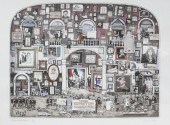 GRAHAM CLARKE (BRITISH B. 1941),
GRAHAM CLARKE (BRITISH B. 1941), PIèCE DE RéSISTANCE, ETCHING AND AQUATINT WITH HAND COLORING ON BARCHAM GREEN HANDMADE PAPER, PLATE SIZE: 21-1/2 X 27-1/4 IN. (54.6 X 69.2 CM.)Graham Clarke, (British, b. 1941) Pièce de Résistance, Etching and aquatint with hand coloring on Barcham Green handmade paper; apparently in good condition. Framed.* Signed Graham Clarke in pencil l.r., titled and numbered 61/400 l.l., published by CCA Galleries and printed by Ebenezer Press Etching and aquatint with hand coloring on Barcham Green handmade paper; apparently in good condition. Framed.* Dimensions: Plate size: 21-1/2 x 27-1/4 in. (54.6 x 69.2 cm.), Frame: 25-1/2 x 36 in. (64.8 x 91.4 cm.) Provenance: Note: Artist Graham Clarkespecializes in etchings, watercolors, and block prints of rural and small-town scenes. He grew up in England following the devastation of World War II, developing a unique visual humor and an affinity for viewing the world through the eyes of ordinary working people. Graham Clarke etchings often hint at humor and caricature, sometimes evoking comparison to Thomas Rowlandson, but without the biting satire.Artist Graham Clarke studied at Beckenham Art School under Samuel Palmer and later at the Royal College of Art with Edward Bawden. These mentors encouraged Clark's interest in traditional landscapes capturing local ambiance accented by his trademark humor. Following graduation in 1964, he came to the attention of Kenneth Clark, an influential art patron whose enthusiasm for Graham Clarke's prints cemented his career.
GRAHAM CLARKE (BRITISH B. 1941),
GRAHAM CLARKE (BRITISH B. 1941), PIèCE DE RéSISTANCE, ETCHING AND AQUATINT WITH HAND COLORING ON BARCHAM GREEN HANDMADE PAPER, PLATE SIZE: 21-1/2 X 27-1/4 IN. (54.6 X 69.2 CM.)Graham Clarke, (British, b. 1941) Pièce de Résistance, Etching and aquatint with hand coloring on Barcham Green handmade paper; apparently in good condition. Framed.* Signed Graham Clarke in pencil l.r., titled and numbered 61/400 l.l., published by CCA Galleries and printed by Ebenezer Press Etching and aquatint with hand coloring on Barcham Green handmade paper; apparently in good condition. Framed.* Dimensions: Plate size: 21-1/2 x 27-1/4 in. (54.6 x 69.2 cm.), Frame: 25-1/2 x 36 in. (64.8 x 91.4 cm.) Provenance: Note: Artist Graham Clarkespecializes in etchings, watercolors, and block prints of rural and small-town scenes. He grew up in England following the devastation of World War II, developing a unique visual humor and an affinity for viewing the world through the eyes of ordinary working people. Graham Clarke etchings often hint at humor and caricature, sometimes evoking comparison to Thomas Rowlandson, but without the biting satire.Artist Graham Clarke studied at Beckenham Art School under Samuel Palmer and later at the Royal College of Art with Edward Bawden. These mentors encouraged Clark's interest in traditional landscapes capturing local ambiance accented by his trademark humor. Following graduation in 1964, he came to the attention of Kenneth Clark, an influential art patron whose enthusiasm for Graham Clarke's prints cemented his career. -
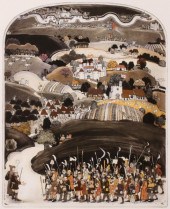 GRAHAM CLARKE (BORN 1941) PENCIL
GRAHAM CLARKE (BORN 1941) PENCIL SIGNED ETCHINGGraham Clarke (Britain, Born 1941)Men of KentThe color etching signed by the artist in pencil below the image lower right is titled lower left and inscribed Artist's Proof edition, blindstamp lower center reads 'History of England.'Plate size 17 x 13.5, frame measures 28.5 x 24 inches.Very good to fine condition, the full untrimmed sheet, not laid down, no damage, stain, puncture or repair; framed to archival standards in acid free mounts. Because this print is from a collection well-known by this auction firm for more than twenty years, it has not been removed from its framing for inspection. As with all lots we offer, the condition is guaranteed to be as stated or a full refund will be issued.
GRAHAM CLARKE (BORN 1941) PENCIL
GRAHAM CLARKE (BORN 1941) PENCIL SIGNED ETCHINGGraham Clarke (Britain, Born 1941)Men of KentThe color etching signed by the artist in pencil below the image lower right is titled lower left and inscribed Artist's Proof edition, blindstamp lower center reads 'History of England.'Plate size 17 x 13.5, frame measures 28.5 x 24 inches.Very good to fine condition, the full untrimmed sheet, not laid down, no damage, stain, puncture or repair; framed to archival standards in acid free mounts. Because this print is from a collection well-known by this auction firm for more than twenty years, it has not been removed from its framing for inspection. As with all lots we offer, the condition is guaranteed to be as stated or a full refund will be issued. -
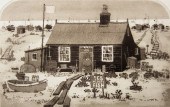 Graham Clarke (born 1941) - Two
Graham Clarke (born 1941) - Two limited edition etchings - \'\'Prospect Cottage\'\' and \'\'Valiant\'\' 13ins x 21ins and 13.5ins x 10.5ins respectively both signed and titled to margins and No. to margins 79 of 100 and 15 of 100 respectively both in silvered frames and glazed
Graham Clarke (born 1941) - Two
Graham Clarke (born 1941) - Two limited edition etchings - \'\'Prospect Cottage\'\' and \'\'Valiant\'\' 13ins x 21ins and 13.5ins x 10.5ins respectively both signed and titled to margins and No. to margins 79 of 100 and 15 of 100 respectively both in silvered frames and glazed -
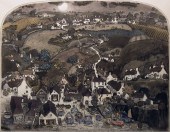 Graham Clarke (born 1941) - Limited
Graham Clarke (born 1941) - Limited edition coloured etching - ''The Nasty Tern'' 21ins x 27ins signed titled and No. 21 of 250 in pencil to margin in wood frame and glazed
Graham Clarke (born 1941) - Limited
Graham Clarke (born 1941) - Limited edition coloured etching - ''The Nasty Tern'' 21ins x 27ins signed titled and No. 21 of 250 in pencil to margin in wood frame and glazed -
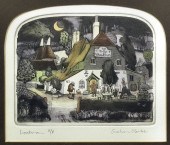 Graham Clark (born 1941) - Three
Graham Clark (born 1941) - Three artists proof coloured etchings - ''Reg's Vegs'' ''Woodman'' and ''Dewdrop'' and a limited edition print - ''Rifleman'' (41 of 500) each 5.25ins x 6.75ins in modern frame and glazed
Graham Clark (born 1941) - Three
Graham Clark (born 1941) - Three artists proof coloured etchings - ''Reg's Vegs'' ''Woodman'' and ''Dewdrop'' and a limited edition print - ''Rifleman'' (41 of 500) each 5.25ins x 6.75ins in modern frame and glazed -
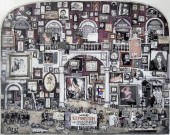 Graham Clarke (born 1941) - Limited
Graham Clarke (born 1941) - Limited edition coloured etching - ''Piece de Resistance'' 21.5ins x 27ins signed titled and No. 21 of 400 to margin and also inscribed in pencil ''For Ricky & Gillian'' in silvered frame and glazed
Graham Clarke (born 1941) - Limited
Graham Clarke (born 1941) - Limited edition coloured etching - ''Piece de Resistance'' 21.5ins x 27ins signed titled and No. 21 of 400 to margin and also inscribed in pencil ''For Ricky & Gillian'' in silvered frame and glazed -
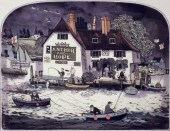 Graham Clarke (born 1941) - limited
Graham Clarke (born 1941) - limited edition colour etching - ''Anchor & Hope'' 10ins x 13ins signed in pencil to margin No. 152 of 400 in grained frame and glazed
Graham Clarke (born 1941) - limited
Graham Clarke (born 1941) - limited edition colour etching - ''Anchor & Hope'' 10ins x 13ins signed in pencil to margin No. 152 of 400 in grained frame and glazed -
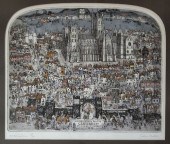 Graham Clarke (born 1941) - Limited
Graham Clarke (born 1941) - Limited edition coloured etching - ''Modus Cantiana'' - An historical aspect of the city of Canterbury 16.75ins x 21.5ins No. 169 of edition of 300 signed and inscribed in pencil in modern silvered moulded frame and glazed
Graham Clarke (born 1941) - Limited
Graham Clarke (born 1941) - Limited edition coloured etching - ''Modus Cantiana'' - An historical aspect of the city of Canterbury 16.75ins x 21.5ins No. 169 of edition of 300 signed and inscribed in pencil in modern silvered moulded frame and glazed -
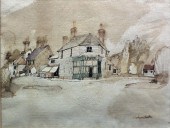 Graham Clark (1941) - Two
Graham Clark (1941) - Two watercolours - ''Piper's Stores Hawkhurst'' and ''Two Boats and a Shrimp Net'' each 7.5ins x 9.75ins signed in modern silvered frames and glazed
Graham Clark (1941) - Two
Graham Clark (1941) - Two watercolours - ''Piper's Stores Hawkhurst'' and ''Two Boats and a Shrimp Net'' each 7.5ins x 9.75ins signed in modern silvered frames and glazed -
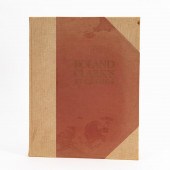 "ROLAND CLARK'S ETCHINGS" DERRYDALE
"ROLAND CLARK'S ETCHINGS" DERRYDALE PRESS 1938 Roland Clark (american, 1874-1957). "Roland Clark's Etchings" -1938, Derrydale Press numbered 467 of 800. "The Morning Flight", etching, pencil signed bound as frontispiece. Half linen and red cloth gilt-lettered, paper spine label. Gift inscription to Robert Woodruff. Approx. h. 16.25", w. 12.75", d. 1"
"ROLAND CLARK'S ETCHINGS" DERRYDALE
"ROLAND CLARK'S ETCHINGS" DERRYDALE PRESS 1938 Roland Clark (american, 1874-1957). "Roland Clark's Etchings" -1938, Derrydale Press numbered 467 of 800. "The Morning Flight", etching, pencil signed bound as frontispiece. Half linen and red cloth gilt-lettered, paper spine label. Gift inscription to Robert Woodruff. Approx. h. 16.25", w. 12.75", d. 1" -
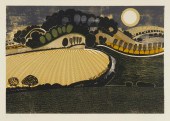 GRAHAM CLARKE (B. 1941), "BEHIND
GRAHAM CLARKE (B. 1941), "BEHIND SHOREHAM," WOODCUT IN COLORS ON PAPER, IMAGE: 18" H X 26" W' SHEET: 26.5" H X 38.75" WGraham Clarke, (b. 1941) "Behind Shoreham", Woodcut in colors on paper Edition: 90/100 Signed, titled, and numbered in pencil in the lower margin: Graham Clarke Woodcut in colors on paper Dimensions: Image: 18" H x 26" W; Sheet: 26.5" H x 38.75" W Provenance: Property of the American Broadcasting Company, New York Walt Disney Co., Burbank, California, acquired by corporate merger with the above Private Collection, Los Angeles, California, acquired from the above
GRAHAM CLARKE (B. 1941), "BEHIND
GRAHAM CLARKE (B. 1941), "BEHIND SHOREHAM," WOODCUT IN COLORS ON PAPER, IMAGE: 18" H X 26" W' SHEET: 26.5" H X 38.75" WGraham Clarke, (b. 1941) "Behind Shoreham", Woodcut in colors on paper Edition: 90/100 Signed, titled, and numbered in pencil in the lower margin: Graham Clarke Woodcut in colors on paper Dimensions: Image: 18" H x 26" W; Sheet: 26.5" H x 38.75" W Provenance: Property of the American Broadcasting Company, New York Walt Disney Co., Burbank, California, acquired by corporate merger with the above Private Collection, Los Angeles, California, acquired from the above -
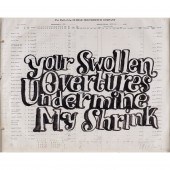 WORK ON PAPER, GRAHAM GILLMORE
WORK ON PAPER, GRAHAM GILLMORE Graham Gillmore (Canadian, b. 1963), "Swollen Overtures," 2004, watercolor on ledger page, signed and dated lower left, collection label affixed verso, sheet: 18.25"h x 22.25"w, overall (with frame): 22.5"h x 26.5"w
WORK ON PAPER, GRAHAM GILLMORE
WORK ON PAPER, GRAHAM GILLMORE Graham Gillmore (Canadian, b. 1963), "Swollen Overtures," 2004, watercolor on ledger page, signed and dated lower left, collection label affixed verso, sheet: 18.25"h x 22.25"w, overall (with frame): 22.5"h x 26.5"w -
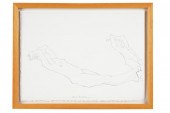 ROBERT GRAHAM (1938-2008): TWO NUDE
ROBERT GRAHAM (1938-2008): TWO NUDE FIGURES1997, etching, signed lower center and dated verso, artist's proof 11 x 15 inches; 12 3/4 x 16 3/4 inches frame Condition:
ROBERT GRAHAM (1938-2008): TWO NUDE
ROBERT GRAHAM (1938-2008): TWO NUDE FIGURES1997, etching, signed lower center and dated verso, artist's proof 11 x 15 inches; 12 3/4 x 16 3/4 inches frame Condition: -
 § GRAHAM SUTHERLAND O.M. (BRITISH
§ GRAHAM SUTHERLAND O.M. (BRITISH 1903-1980) PECKEN WOOD, 1925 (TASSI 21) Etching, signed in pencil to margin13.5cm (5 1/4in), 18cm (7in)Provenance: Mrs A. M. Bernhard-Smith, Twenty-One Gallery, LondonChristie's, South Kensington, 19th May 2016, lot 51.Literature: Roberto Tassi and Edward Quinn, Graham Sutherland: Complete Graphic Work, London 1988, no.21.Gordon Cooke, Graham Sutherland: Early Etchings, London 1993, no.10.Graham Sutherland specialised in etching whilst a student at London University’s Goldsmith’s College School of Art between 1921 and 1926. He was taught by Malcolm Osborne and Stanley Anderson and trained alongside Paul Drury and William Larkins. It was during this formative period that he made the following group of etchings, with May Green created in 1927; all of them reveal his precocious and emerging talent. Indeed, Sutherland established his professional standing as a printmaker and held his first solo exhibition in 1924, at the Twenty-One Gallery in London. The following year he was elected an Associate Member of the Royal Society of Painter-Etchers and Engraves. Shortly after graduating, he was appointed to the staff of Chelsea College of Art, where he taught engraving until 1932.In 1924, Larkins found an impression of The Herdman’s Cottage etching of 1850 by the visionary artist Samuel Palmer (1805-81) in a shop on the Charing Cross Road and showed it to his fellow students. Sutherland recalled the impact it had on him: ‘I remember that I was amazed at its completeness, both emotional and technical. It was unheard of at the school to cover the plate almost completely with work and quite new to us that the complex variety of the multiplicity of lines could form a tone of such luminosity…As we became familiar with Palmer’s later etchings, we ‘bit’ our plates deeper. We had always been warned against ‘overbiting’. But we did ‘overbite’ and we ‘burnished’ our way through innumerable ‘states’ quite unrepentant at the way we punished and maltreated the copper…It seemed to me wonderful that a strong emotion, such as was Palmer’s, could change and transform the appearance of things.’ (1)Palmer’s reputation had diminished since his death in 1881, but was resurrected when an exhibition of his work was mounted at the Victoria and Albert Museum in London in 1926. As illustrated in the current group, Roberto Tassi has explained that Palmer’s influence on Sutherland’s etchings showed ‘in the presence of the sun and its light shining through the trees, the starry sky streaked with horizontal clouds, the contrast between the evening dusk that is already creeping over the land in thickening shadows and the soaring beams of the setting sun.’ (2)Sutherland engaged with and extended the English pastoral tradition and its idealism, with Gordon Cooke proclaiming: ‘Prints such as Village, Pecken Wood, Cray Fields, St Mary Hatch, Lammas and May Green concern the unchanging experience of life in the countryside, the generations which have worked in it and lived from it and the manner in which nature rules such a way of life.’ (3) Yet Sutherland’s etched images of the mid-1920s are also laced with nostalgia - as rural communities changed - and with an embracing of religion which culminated in his acceptance into the Roman Catholic church in 1926.Tassi continues: ‘Throughout this period, the influence of Palmer continues, most noticeably in the atmosphere, which seems to be suspended, wrapped in mystery and a tinge of mysticism. The sun, the doves, the stars, the birds and the sheep all become religious symbols; the air is one of enchantment; the contrast between light and shade, though violent, is not disturbing, but seems rather to diffuse an air or quietude over the world. In general, however, the feeling is one of abstraction rather than life.’ (4)Sutherland’s success as an etcher came to an abrupt end with the collapse of the art market following the Wall Street crash of 1929. He turned to painting, but returned to print-making at various points during his career, including lithography in the 1940s and 1950s before a resumption of etching in the 1970s.(1) As quoted in Ronald Alley, Graham Sutherland, London, 1982, p 9.(2) Roberto Tassi and Edward Quinn, Graham Sutherland: Complete Graphic Work, London 1978, p.19(3) Gordon Cooke, Graham Sutherland: Early Etchings, London 1993, unpaginated(4) Tassi op.cit., p.20Note: Ronald Alley has written about this work that the rural world it depicts ‘is one of the past, the evocation of a mode of village life which had almost completely passed away. The emphasis is on the autumnal fertility of nature, with man living in communion with nature and...the moment depicted is when the sun is setting, or near setting and the stars are beginning to come out.' (Ronald Alley, Graham Sutherland, London 1983, p. 59)
§ GRAHAM SUTHERLAND O.M. (BRITISH
§ GRAHAM SUTHERLAND O.M. (BRITISH 1903-1980) PECKEN WOOD, 1925 (TASSI 21) Etching, signed in pencil to margin13.5cm (5 1/4in), 18cm (7in)Provenance: Mrs A. M. Bernhard-Smith, Twenty-One Gallery, LondonChristie's, South Kensington, 19th May 2016, lot 51.Literature: Roberto Tassi and Edward Quinn, Graham Sutherland: Complete Graphic Work, London 1988, no.21.Gordon Cooke, Graham Sutherland: Early Etchings, London 1993, no.10.Graham Sutherland specialised in etching whilst a student at London University’s Goldsmith’s College School of Art between 1921 and 1926. He was taught by Malcolm Osborne and Stanley Anderson and trained alongside Paul Drury and William Larkins. It was during this formative period that he made the following group of etchings, with May Green created in 1927; all of them reveal his precocious and emerging talent. Indeed, Sutherland established his professional standing as a printmaker and held his first solo exhibition in 1924, at the Twenty-One Gallery in London. The following year he was elected an Associate Member of the Royal Society of Painter-Etchers and Engraves. Shortly after graduating, he was appointed to the staff of Chelsea College of Art, where he taught engraving until 1932.In 1924, Larkins found an impression of The Herdman’s Cottage etching of 1850 by the visionary artist Samuel Palmer (1805-81) in a shop on the Charing Cross Road and showed it to his fellow students. Sutherland recalled the impact it had on him: ‘I remember that I was amazed at its completeness, both emotional and technical. It was unheard of at the school to cover the plate almost completely with work and quite new to us that the complex variety of the multiplicity of lines could form a tone of such luminosity…As we became familiar with Palmer’s later etchings, we ‘bit’ our plates deeper. We had always been warned against ‘overbiting’. But we did ‘overbite’ and we ‘burnished’ our way through innumerable ‘states’ quite unrepentant at the way we punished and maltreated the copper…It seemed to me wonderful that a strong emotion, such as was Palmer’s, could change and transform the appearance of things.’ (1)Palmer’s reputation had diminished since his death in 1881, but was resurrected when an exhibition of his work was mounted at the Victoria and Albert Museum in London in 1926. As illustrated in the current group, Roberto Tassi has explained that Palmer’s influence on Sutherland’s etchings showed ‘in the presence of the sun and its light shining through the trees, the starry sky streaked with horizontal clouds, the contrast between the evening dusk that is already creeping over the land in thickening shadows and the soaring beams of the setting sun.’ (2)Sutherland engaged with and extended the English pastoral tradition and its idealism, with Gordon Cooke proclaiming: ‘Prints such as Village, Pecken Wood, Cray Fields, St Mary Hatch, Lammas and May Green concern the unchanging experience of life in the countryside, the generations which have worked in it and lived from it and the manner in which nature rules such a way of life.’ (3) Yet Sutherland’s etched images of the mid-1920s are also laced with nostalgia - as rural communities changed - and with an embracing of religion which culminated in his acceptance into the Roman Catholic church in 1926.Tassi continues: ‘Throughout this period, the influence of Palmer continues, most noticeably in the atmosphere, which seems to be suspended, wrapped in mystery and a tinge of mysticism. The sun, the doves, the stars, the birds and the sheep all become religious symbols; the air is one of enchantment; the contrast between light and shade, though violent, is not disturbing, but seems rather to diffuse an air or quietude over the world. In general, however, the feeling is one of abstraction rather than life.’ (4)Sutherland’s success as an etcher came to an abrupt end with the collapse of the art market following the Wall Street crash of 1929. He turned to painting, but returned to print-making at various points during his career, including lithography in the 1940s and 1950s before a resumption of etching in the 1970s.(1) As quoted in Ronald Alley, Graham Sutherland, London, 1982, p 9.(2) Roberto Tassi and Edward Quinn, Graham Sutherland: Complete Graphic Work, London 1978, p.19(3) Gordon Cooke, Graham Sutherland: Early Etchings, London 1993, unpaginated(4) Tassi op.cit., p.20Note: Ronald Alley has written about this work that the rural world it depicts ‘is one of the past, the evocation of a mode of village life which had almost completely passed away. The emphasis is on the autumnal fertility of nature, with man living in communion with nature and...the moment depicted is when the sun is setting, or near setting and the stars are beginning to come out.' (Ronald Alley, Graham Sutherland, London 1983, p. 59) -
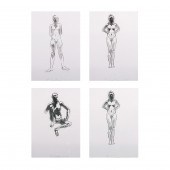 PRINTS, ROBERT GRAHAM (lot of 4)
PRINTS, ROBERT GRAHAM (lot of 4) Robert Graham (American, 1938-2008), Nudes, 1993, lithographs, each pencil signed and dated lower center, sheet (each): 15"h x 10.75"w, overall (with frame (each): 20"h x 16"w
PRINTS, ROBERT GRAHAM (lot of 4)
PRINTS, ROBERT GRAHAM (lot of 4) Robert Graham (American, 1938-2008), Nudes, 1993, lithographs, each pencil signed and dated lower center, sheet (each): 15"h x 10.75"w, overall (with frame (each): 20"h x 16"w -
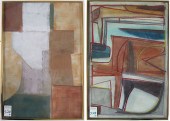 MARK CLARKE TWO MIXED MEDIAS ON
MARK CLARKE TWO MIXED MEDIAS ON PAPER (Oregon 20th century) Abstract compositions with geometric shapes. Images measure 22'' x 15'' pencil signed ''M. Clarke.'' Set in aluminum frames.
MARK CLARKE TWO MIXED MEDIAS ON
MARK CLARKE TWO MIXED MEDIAS ON PAPER (Oregon 20th century) Abstract compositions with geometric shapes. Images measure 22'' x 15'' pencil signed ''M. Clarke.'' Set in aluminum frames. -
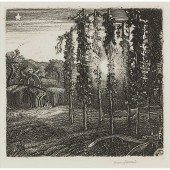 § GRAHAM SUTHERLAND O.M. (BRITISH
§ GRAHAM SUTHERLAND O.M. (BRITISH 1903-1980) CRAY FIELDS, 1925 (TASSI 19) Etching, signed in pencil to marginimage size 11.5cm (4 1/2in), 12cm (4 3/4in)Provenance: Mrs A. M. Bernhard-Smith, Twenty-One Gallery, LondonChristie's, South Kensington, 19th May 2016, lot 55.Literature: Roberto Tassi and Edward Quinn, Graham Sutherland: Complete Graphic Work, London 1988, no.19.Gordon Cooke, Graham Sutherland: Early Etchings, London 1993, no.11.Graham Sutherland specialised in etching whilst a student at London University’s Goldsmith’s College School of Art between 1921 and 1926. He was taught by Malcolm Osborne and Stanley Anderson and trained alongside Paul Drury and William Larkins. It was during this formative period that he made the following group of etchings, with May Green created in 1927; all of them reveal his precocious and emerging talent. Indeed, Sutherland established his professional standing as a printmaker and held his first solo exhibition in 1924, at the Twenty-One Gallery in London. The following year he was elected an Associate Member of the Royal Society of Painter-Etchers and Engraves. Shortly after graduating, he was appointed to the staff of Chelsea College of Art, where he taught engraving until 1932.In 1924, Larkins found an impression of The Herdman’s Cottage etching of 1850 by the visionary artist Samuel Palmer (1805-81) in a shop on the Charing Cross Road and showed it to his fellow students. Sutherland recalled the impact it had on him: ‘I remember that I was amazed at its completeness, both emotional and technical. It was unheard of at the school to cover the plate almost completely with work and quite new to us that the complex variety of the multiplicity of lines could form a tone of such luminosity…As we became familiar with Palmer’s later etchings, we ‘bit’ our plates deeper. We had always been warned against ‘overbiting’. But we did ‘overbite’ and we ‘burnished’ our way through innumerable ‘states’ quite unrepentant at the way we punished and maltreated the copper…It seemed to me wonderful that a strong emotion, such as was Palmer’s, could change and transform the appearance of things.’ (1)Palmer’s reputation had diminished since his death in 1881, but was resurrected when an exhibition of his work was mounted at the Victoria and Albert Museum in London in 1926. As illustrated in the current group, Roberto Tassi has explained that Palmer’s influence on Sutherland’s etchings showed ‘in the presence of the sun and its light shining through the trees, the starry sky streaked with horizontal clouds, the contrast between the evening dusk that is already creeping over the land in thickening shadows and the soaring beams of the setting sun.’ (2)Sutherland engaged with and extended the English pastoral tradition and its idealism, with Gordon Cooke proclaiming: ‘Prints such as Village, Pecken Wood, Cray Fields, St Mary Hatch, Lammas and May Green concern the unchanging experience of life in the countryside, the generations which have worked in it and lived from it and the manner in which nature rules such a way of life.’ (3) Yet Sutherland’s etched images of the mid-1920s are also laced with nostalgia - as rural communities changed - and with an embracing of religion which culminated in his acceptance into the Roman Catholic church in 1926.Tassi continues: ‘Throughout this period, the influence of Palmer continues, most noticeably in the atmosphere, which seems to be suspended, wrapped in mystery and a tinge of mysticism. The sun, the doves, the stars, the birds and the sheep all become religious symbols; the air is one of enchantment; the contrast between light and shade, though violent, is not disturbing, but seems rather to diffuse an air or quietude over the world. In general, however, the feeling is one of abstraction rather than life.’ (4)Sutherland’s success as an etcher came to an abrupt end with the collapse of the art market following the Wall Street crash of 1929. He turned to painting, but returned to print-making at various points during his career, including lithography in the 1940s and 1950s before a resumption of etching in the 1970s.(1) As quoted in Ronald Alley, Graham Sutherland, London, 1982, p 9.(2) Roberto Tassi and Edward Quinn, Graham Sutherland: Complete Graphic Work, London 1978, p.19(3) Gordon Cooke, Graham Sutherland: Early Etchings, London 1993, unpaginated(4) Tassi op.cit., p.20Note: Gordon Cooke has noted that 'the Cray is a river, rising at St Mary Cray, near Farningham, where Graham Sutherland moved in 1927' (op.cit., unpaginated). Roberto Tassi has remarked that in this work ‘the bewitching atmosphere of [Samuel] Palmer…is clearly in the ascendant here, as we can see from the stars, the tall spikes and line of hop-poles’. (op.cit., p. 20)
§ GRAHAM SUTHERLAND O.M. (BRITISH
§ GRAHAM SUTHERLAND O.M. (BRITISH 1903-1980) CRAY FIELDS, 1925 (TASSI 19) Etching, signed in pencil to marginimage size 11.5cm (4 1/2in), 12cm (4 3/4in)Provenance: Mrs A. M. Bernhard-Smith, Twenty-One Gallery, LondonChristie's, South Kensington, 19th May 2016, lot 55.Literature: Roberto Tassi and Edward Quinn, Graham Sutherland: Complete Graphic Work, London 1988, no.19.Gordon Cooke, Graham Sutherland: Early Etchings, London 1993, no.11.Graham Sutherland specialised in etching whilst a student at London University’s Goldsmith’s College School of Art between 1921 and 1926. He was taught by Malcolm Osborne and Stanley Anderson and trained alongside Paul Drury and William Larkins. It was during this formative period that he made the following group of etchings, with May Green created in 1927; all of them reveal his precocious and emerging talent. Indeed, Sutherland established his professional standing as a printmaker and held his first solo exhibition in 1924, at the Twenty-One Gallery in London. The following year he was elected an Associate Member of the Royal Society of Painter-Etchers and Engraves. Shortly after graduating, he was appointed to the staff of Chelsea College of Art, where he taught engraving until 1932.In 1924, Larkins found an impression of The Herdman’s Cottage etching of 1850 by the visionary artist Samuel Palmer (1805-81) in a shop on the Charing Cross Road and showed it to his fellow students. Sutherland recalled the impact it had on him: ‘I remember that I was amazed at its completeness, both emotional and technical. It was unheard of at the school to cover the plate almost completely with work and quite new to us that the complex variety of the multiplicity of lines could form a tone of such luminosity…As we became familiar with Palmer’s later etchings, we ‘bit’ our plates deeper. We had always been warned against ‘overbiting’. But we did ‘overbite’ and we ‘burnished’ our way through innumerable ‘states’ quite unrepentant at the way we punished and maltreated the copper…It seemed to me wonderful that a strong emotion, such as was Palmer’s, could change and transform the appearance of things.’ (1)Palmer’s reputation had diminished since his death in 1881, but was resurrected when an exhibition of his work was mounted at the Victoria and Albert Museum in London in 1926. As illustrated in the current group, Roberto Tassi has explained that Palmer’s influence on Sutherland’s etchings showed ‘in the presence of the sun and its light shining through the trees, the starry sky streaked with horizontal clouds, the contrast between the evening dusk that is already creeping over the land in thickening shadows and the soaring beams of the setting sun.’ (2)Sutherland engaged with and extended the English pastoral tradition and its idealism, with Gordon Cooke proclaiming: ‘Prints such as Village, Pecken Wood, Cray Fields, St Mary Hatch, Lammas and May Green concern the unchanging experience of life in the countryside, the generations which have worked in it and lived from it and the manner in which nature rules such a way of life.’ (3) Yet Sutherland’s etched images of the mid-1920s are also laced with nostalgia - as rural communities changed - and with an embracing of religion which culminated in his acceptance into the Roman Catholic church in 1926.Tassi continues: ‘Throughout this period, the influence of Palmer continues, most noticeably in the atmosphere, which seems to be suspended, wrapped in mystery and a tinge of mysticism. The sun, the doves, the stars, the birds and the sheep all become religious symbols; the air is one of enchantment; the contrast between light and shade, though violent, is not disturbing, but seems rather to diffuse an air or quietude over the world. In general, however, the feeling is one of abstraction rather than life.’ (4)Sutherland’s success as an etcher came to an abrupt end with the collapse of the art market following the Wall Street crash of 1929. He turned to painting, but returned to print-making at various points during his career, including lithography in the 1940s and 1950s before a resumption of etching in the 1970s.(1) As quoted in Ronald Alley, Graham Sutherland, London, 1982, p 9.(2) Roberto Tassi and Edward Quinn, Graham Sutherland: Complete Graphic Work, London 1978, p.19(3) Gordon Cooke, Graham Sutherland: Early Etchings, London 1993, unpaginated(4) Tassi op.cit., p.20Note: Gordon Cooke has noted that 'the Cray is a river, rising at St Mary Cray, near Farningham, where Graham Sutherland moved in 1927' (op.cit., unpaginated). Roberto Tassi has remarked that in this work ‘the bewitching atmosphere of [Samuel] Palmer…is clearly in the ascendant here, as we can see from the stars, the tall spikes and line of hop-poles’. (op.cit., p. 20) -
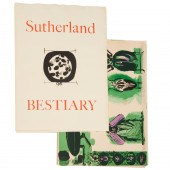 GRAHAM SUTHERLAND, PORTFOLIO (25)
GRAHAM SUTHERLAND, PORTFOLIO (25) LITHOGRAPHS 1965 Graham Vivian Sutherland (British,1903-1980), "A Bestiary and Some Correspondences", the complete portfolio, on Arches wove paper, each pencil signed and numbered 2/70 (plus 10 artist's proofs), published by Marlborough Fine Art, London, includes title page, edition page and index of images, in original double-boxed cardboard portfolio, 26"h x 19.5"w (sheet), 28"h x 22"w x 2"d (portfolio box)
GRAHAM SUTHERLAND, PORTFOLIO (25)
GRAHAM SUTHERLAND, PORTFOLIO (25) LITHOGRAPHS 1965 Graham Vivian Sutherland (British,1903-1980), "A Bestiary and Some Correspondences", the complete portfolio, on Arches wove paper, each pencil signed and numbered 2/70 (plus 10 artist's proofs), published by Marlborough Fine Art, London, includes title page, edition page and index of images, in original double-boxed cardboard portfolio, 26"h x 19.5"w (sheet), 28"h x 22"w x 2"d (portfolio box) -
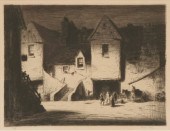 Two etchings by Joseph Gray and a
Two etchings by Joseph Gray and a mezzotint by Zella de Milhau. Joseph Gray (British, 1890-1962), evening courtyard and street scenes, both pencil signed, largest is 11 3/4" x 11 1/4". Zella de Milhau (American, 1870-1954), "Night, Shinnecock Hills" mezzotint, pencil signed in the margin, 5" x 7 3/4". A painter and etcher, Zella De Milhau was a student of William Merritt Chase at his summer school at Shinnecock, Long Island.
Two etchings by Joseph Gray and a
Two etchings by Joseph Gray and a mezzotint by Zella de Milhau. Joseph Gray (British, 1890-1962), evening courtyard and street scenes, both pencil signed, largest is 11 3/4" x 11 1/4". Zella de Milhau (American, 1870-1954), "Night, Shinnecock Hills" mezzotint, pencil signed in the margin, 5" x 7 3/4". A painter and etcher, Zella De Milhau was a student of William Merritt Chase at his summer school at Shinnecock, Long Island. -
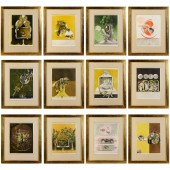 GRAHAM SUTHERLAND, PORTFOLIO (12)
GRAHAM SUTHERLAND, PORTFOLIO (12) AQUATINTS, 1977 Graham Vivian Sutherland (British,1903-1980), the complete "Bees" Standard Edition, each signed and dated 37/66 along lower margins, including the cardboard portfolio case with pen signed front sheet, pencil numbered edition page, and all accompanying text pages, a joint publication between Marlborough Fine Art Ltd. 6 Albemerle Street London and 2RC Editrice Vicolo degli Astalli 5 Roma, each plate matted and framed, 16.5"h x 13"w (sight), 26"h x 21"w (frame)
GRAHAM SUTHERLAND, PORTFOLIO (12)
GRAHAM SUTHERLAND, PORTFOLIO (12) AQUATINTS, 1977 Graham Vivian Sutherland (British,1903-1980), the complete "Bees" Standard Edition, each signed and dated 37/66 along lower margins, including the cardboard portfolio case with pen signed front sheet, pencil numbered edition page, and all accompanying text pages, a joint publication between Marlborough Fine Art Ltd. 6 Albemerle Street London and 2RC Editrice Vicolo degli Astalli 5 Roma, each plate matted and framed, 16.5"h x 13"w (sight), 26"h x 21"w (frame) -
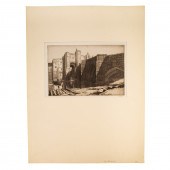 FREDERICK LANDSEER GRIGGS."THE
FREDERICK LANDSEER GRIGGS."THE CRESSET," ETCHING (British, 1876-1938). Etching, 1915, pencil signed "F.L. Griggs" lr, sheet size: 8 1/2 x 13 in., unframed.
FREDERICK LANDSEER GRIGGS."THE
FREDERICK LANDSEER GRIGGS."THE CRESSET," ETCHING (British, 1876-1938). Etching, 1915, pencil signed "F.L. Griggs" lr, sheet size: 8 1/2 x 13 in., unframed. -
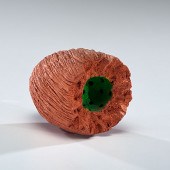 Graham Marks (1951 USA) Untitled
Graham Marks (1951 USA) Untitled Miniatureca 1980Ceramic; ht. 3.5 dia 2.75 in. Daniel Jacobs and Derek Mason Collection; Acquired directly from the Artist.
Graham Marks (1951 USA) Untitled
Graham Marks (1951 USA) Untitled Miniatureca 1980Ceramic; ht. 3.5 dia 2.75 in. Daniel Jacobs and Derek Mason Collection; Acquired directly from the Artist. -
 Philippa Blair (New Zealand b.
Philippa Blair (New Zealand b. 1945) Untitled (a pair of works) etchings edition 12/25 5/25 each signed P. Blair (lower right) 9 1/2 x 9 1/2 inches each.
Philippa Blair (New Zealand b.
Philippa Blair (New Zealand b. 1945) Untitled (a pair of works) etchings edition 12/25 5/25 each signed P. Blair (lower right) 9 1/2 x 9 1/2 inches each. -
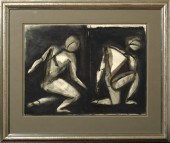 Chris Clark (American/New
Chris Clark (American/New Orleans, Contemporary) "Two Figures", ca. 1980's, ink wash and charcoal on rag paper, signed and dated on the reverse of sheet, 22" x 30". Glazed, handsomely matted and presented in a contemporary silvered frame.
Chris Clark (American/New
Chris Clark (American/New Orleans, Contemporary) "Two Figures", ca. 1980's, ink wash and charcoal on rag paper, signed and dated on the reverse of sheet, 22" x 30". Glazed, handsomely matted and presented in a contemporary silvered frame. -
 GUILLAUME AZOULAY. "LA CLUIKE," TWO
GUILLAUME AZOULAY. "LA CLUIKE," TWO ETCHINGS Two etchings, each pencil signed, sheet sizes: 22 1/2 x 30 in., unframed.
GUILLAUME AZOULAY. "LA CLUIKE," TWO
GUILLAUME AZOULAY. "LA CLUIKE," TWO ETCHINGS Two etchings, each pencil signed, sheet sizes: 22 1/2 x 30 in., unframed. -
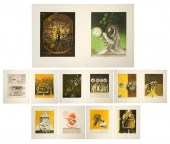 GRAHAM SUTHERLAND 'BEES' 12
GRAHAM SUTHERLAND 'BEES' 12 ETCHINGS / AQUATINTSGraham Sutherland, United Kingdom (1903-1980). Collection of 12 etchings and aquatints in color, featuring the life cycle of bees and highlighting the relationship among the queen, the workers and drones within the hive. Joint publication between Marlborough Fine Art and 2RC Editrice, printed in 1977. All are signed in pencil lower right. Paper measures 22.25"H x 17.75"W; 15.75"H x 12.25"W visual. Includes 'Expulsion and Killing of an Enemy', 'Figure of Eight Dance'', 'Bee and Flower', 'Bee keeper', 'Fight Between Workers and Drones', 'Hatching', Hatching II', 'Metamorphosis', 'Nuptial Flight', 'Primitive Hive', 'The Court', 'Wild Nest'.
GRAHAM SUTHERLAND 'BEES' 12
GRAHAM SUTHERLAND 'BEES' 12 ETCHINGS / AQUATINTSGraham Sutherland, United Kingdom (1903-1980). Collection of 12 etchings and aquatints in color, featuring the life cycle of bees and highlighting the relationship among the queen, the workers and drones within the hive. Joint publication between Marlborough Fine Art and 2RC Editrice, printed in 1977. All are signed in pencil lower right. Paper measures 22.25"H x 17.75"W; 15.75"H x 12.25"W visual. Includes 'Expulsion and Killing of an Enemy', 'Figure of Eight Dance'', 'Bee and Flower', 'Bee keeper', 'Fight Between Workers and Drones', 'Hatching', Hatching II', 'Metamorphosis', 'Nuptial Flight', 'Primitive Hive', 'The Court', 'Wild Nest'. -
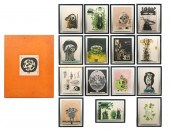 GRAHAM SUTHERLAND 'THE BESTIARY' 25
GRAHAM SUTHERLAND 'THE BESTIARY' 25 ETCHINGSGraham Sutherland, United Kingdom (1903-1980). This set of etchings and aquatints on Arches paper consists of 15 framed etchings (including a table of contents). *Please email us for all the photos* Measures 32"H x 26"W framed; 26"H x 19.5"W paper. Also 11 unframed etchings in a linen covered portfolio (measures 26"H x 20"W paper; 27.75"H x 21.5"W x 1.75"D portfolio). All signed lower right. Published by Marlborough Fine Art, London.
GRAHAM SUTHERLAND 'THE BESTIARY' 25
GRAHAM SUTHERLAND 'THE BESTIARY' 25 ETCHINGSGraham Sutherland, United Kingdom (1903-1980). This set of etchings and aquatints on Arches paper consists of 15 framed etchings (including a table of contents). *Please email us for all the photos* Measures 32"H x 26"W framed; 26"H x 19.5"W paper. Also 11 unframed etchings in a linen covered portfolio (measures 26"H x 20"W paper; 27.75"H x 21.5"W x 1.75"D portfolio). All signed lower right. Published by Marlborough Fine Art, London. -
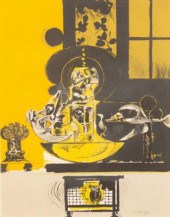 Graham Sutherland, OM
Graham Sutherland, OM (1903-1980)/'La Tour des Oiseaux'/1976/signed in pencil and numbered XXXIV/L, printed by Mourlot, Paris/lithograph in six colours 65cm x 50cm
Graham Sutherland, OM
Graham Sutherland, OM (1903-1980)/'La Tour des Oiseaux'/1976/signed in pencil and numbered XXXIV/L, printed by Mourlot, Paris/lithograph in six colours 65cm x 50cm -
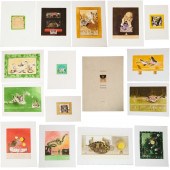 GRAHAM SUTHERLAND, PORTFOLIO (15)
GRAHAM SUTHERLAND, PORTFOLIO (15) AQUATINTS, 1978 Graham Vivian Sutherland (British,1903-1980) , "Apollinaire: Le Bestiaire ou Cortege d'Orphee" (The Bestiary or the Procession of Orpheus) Standard Edition, on Magnani paper, each pencil signed and numbered 30/75 along lower margins, each blind stamped with artist monogram and printer's stamp, jointly published by Marlborough Fine Art, London and 2RC Editrice, Milan, various sizes, in original cardboard portfolio box, with front plate, edition page, text pages and print dividers, 35"h x 26"w x 2"d (portfolio box)
GRAHAM SUTHERLAND, PORTFOLIO (15)
GRAHAM SUTHERLAND, PORTFOLIO (15) AQUATINTS, 1978 Graham Vivian Sutherland (British,1903-1980) , "Apollinaire: Le Bestiaire ou Cortege d'Orphee" (The Bestiary or the Procession of Orpheus) Standard Edition, on Magnani paper, each pencil signed and numbered 30/75 along lower margins, each blind stamped with artist monogram and printer's stamp, jointly published by Marlborough Fine Art, London and 2RC Editrice, Milan, various sizes, in original cardboard portfolio box, with front plate, edition page, text pages and print dividers, 35"h x 26"w x 2"d (portfolio box) -
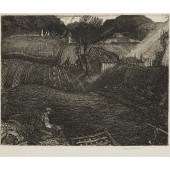 § GRAHAM SUTHERLAND O.M. (BRITISH
§ GRAHAM SUTHERLAND O.M. (BRITISH 1903-1980) THE VILLAGE, 1925 (TASSI 20) Etching, signed in pencil to margin17cm (6 3/4in), 22cm (8 3/4in)Provenance: Christie's, South Kensington, 16th April 2014, lot 120.Literature: Roberto Tassi and Edward Quinn, Graham Sutherland: Complete Graphic Work, London 1988, no.20.Gordon Cooke, Graham Sutherland: Early Etchings, London 1993, no. 9.Graham Sutherland specialised in etching whilst a student at London University’s Goldsmith’s College School of Art between 1921 and 1926. He was taught by Malcolm Osborne and Stanley Anderson and trained alongside Paul Drury and William Larkins. It was during this formative period that he made the following group of etchings, with May Green created in 1927; all of them reveal his precocious and emerging talent. Indeed, Sutherland established his professional standing as a printmaker and held his first solo exhibition in 1924, at the Twenty-One Gallery in London. The following year he was elected an Associate Member of the Royal Society of Painter-Etchers and Engraves. Shortly after graduating, he was appointed to the staff of Chelsea College of Art, where he taught engraving until 1932.In 1924, Larkins found an impression of The Herdman’s Cottage etching of 1850 by the visionary artist Samuel Palmer (1805-81) in a shop on the Charing Cross Road and showed it to his fellow students. Sutherland recalled the impact it had on him: ‘I remember that I was amazed at its completeness, both emotional and technical. It was unheard of at the school to cover the plate almost completely with work and quite new to us that the complex variety of the multiplicity of lines could form a tone of such luminosity…As we became familiar with Palmer’s later etchings, we ‘bit’ our plates deeper. We had always been warned against ‘overbiting’. But we did ‘overbite’ and we ‘burnished’ our way through innumerable ‘states’ quite unrepentant at the way we punished and maltreated the copper…It seemed to me wonderful that a strong emotion, such as was Palmer’s, could change and transform the appearance of things.’ (1)Palmer’s reputation had diminished since his death in 1881, but was resurrected when an exhibition of his work was mounted at the Victoria and Albert Museum in London in 1926. As illustrated in the current group, Roberto Tassi has explained that Palmer’s influence on Sutherland’s etchings showed ‘in the presence of the sun and its light shining through the trees, the starry sky streaked with horizontal clouds, the contrast between the evening dusk that is already creeping over the land in thickening shadows and the soaring beams of the setting sun.’ (2)Sutherland engaged with and extended the English pastoral tradition and its idealism, with Gordon Cooke proclaiming: ‘Prints such as Village, Pecken Wood, Cray Fields, St Mary Hatch, Lammas and May Green concern the unchanging experience of life in the countryside, the generations which have worked in it and lived from it and the manner in which nature rules such a way of life.’ (3) Yet Sutherland’s etched images of the mid-1920s are also laced with nostalgia - as rural communities changed - and with an embracing of religion which culminated in his acceptance into the Roman Catholic church in 1926.Tassi continues: ‘Throughout this period, the influence of Palmer continues, most noticeably in the atmosphere, which seems to be suspended, wrapped in mystery and a tinge of mysticism. The sun, the doves, the stars, the birds and the sheep all become religious symbols; the air is one of enchantment; the contrast between light and shade, though violent, is not disturbing, but seems rather to diffuse an air of quietude over the world. In general, however, the feeling is one of abstraction rather than life.’ (4)Sutherland’s success as an etcher came to an abrupt end with the collapse of the art market following the Wall Street crash of 1929. He turned to painting, but returned to print-making at various points during his career, including lithography in the 1940s and 1950s before a resumption of etching in the 1970s.(1) As quoted in Ronald Alley, Graham Sutherland, London, 1982, p 9.(2) Roberto Tassi and Edward Quinn, Graham Sutherland: Complete Graphic Work, London 1978, p.19(3) Gordon Cooke, Graham Sutherland: Early Etchings, London 1993, unpaginated(4) Tassi op.cit., p.20Note: Gordon Cooke has linked The Village to Samuel Palmer's etching The Bellman of 1879 (op.cit., unpaginated, see Victoria & Albert Museum collection acc. no.E.1465-1926). In contrast, Roberto Tassi detected the influence of Jean-François Millet and declared that The Village revealed 'a new and absolutely original vision...with tilled fields, weary labourers, their wretched cottages and the evening stillness that weighs on everything.' (op.cit., p. 19) Ronald Alley has explained that the scene depicted was 'based mainly on scenery around Cudham in Kent, but with elements from Warning Camp in Sussex.’ (Ronald Alley, Graham Sutherland, London 1982, p. 58.)
§ GRAHAM SUTHERLAND O.M. (BRITISH
§ GRAHAM SUTHERLAND O.M. (BRITISH 1903-1980) THE VILLAGE, 1925 (TASSI 20) Etching, signed in pencil to margin17cm (6 3/4in), 22cm (8 3/4in)Provenance: Christie's, South Kensington, 16th April 2014, lot 120.Literature: Roberto Tassi and Edward Quinn, Graham Sutherland: Complete Graphic Work, London 1988, no.20.Gordon Cooke, Graham Sutherland: Early Etchings, London 1993, no. 9.Graham Sutherland specialised in etching whilst a student at London University’s Goldsmith’s College School of Art between 1921 and 1926. He was taught by Malcolm Osborne and Stanley Anderson and trained alongside Paul Drury and William Larkins. It was during this formative period that he made the following group of etchings, with May Green created in 1927; all of them reveal his precocious and emerging talent. Indeed, Sutherland established his professional standing as a printmaker and held his first solo exhibition in 1924, at the Twenty-One Gallery in London. The following year he was elected an Associate Member of the Royal Society of Painter-Etchers and Engraves. Shortly after graduating, he was appointed to the staff of Chelsea College of Art, where he taught engraving until 1932.In 1924, Larkins found an impression of The Herdman’s Cottage etching of 1850 by the visionary artist Samuel Palmer (1805-81) in a shop on the Charing Cross Road and showed it to his fellow students. Sutherland recalled the impact it had on him: ‘I remember that I was amazed at its completeness, both emotional and technical. It was unheard of at the school to cover the plate almost completely with work and quite new to us that the complex variety of the multiplicity of lines could form a tone of such luminosity…As we became familiar with Palmer’s later etchings, we ‘bit’ our plates deeper. We had always been warned against ‘overbiting’. But we did ‘overbite’ and we ‘burnished’ our way through innumerable ‘states’ quite unrepentant at the way we punished and maltreated the copper…It seemed to me wonderful that a strong emotion, such as was Palmer’s, could change and transform the appearance of things.’ (1)Palmer’s reputation had diminished since his death in 1881, but was resurrected when an exhibition of his work was mounted at the Victoria and Albert Museum in London in 1926. As illustrated in the current group, Roberto Tassi has explained that Palmer’s influence on Sutherland’s etchings showed ‘in the presence of the sun and its light shining through the trees, the starry sky streaked with horizontal clouds, the contrast between the evening dusk that is already creeping over the land in thickening shadows and the soaring beams of the setting sun.’ (2)Sutherland engaged with and extended the English pastoral tradition and its idealism, with Gordon Cooke proclaiming: ‘Prints such as Village, Pecken Wood, Cray Fields, St Mary Hatch, Lammas and May Green concern the unchanging experience of life in the countryside, the generations which have worked in it and lived from it and the manner in which nature rules such a way of life.’ (3) Yet Sutherland’s etched images of the mid-1920s are also laced with nostalgia - as rural communities changed - and with an embracing of religion which culminated in his acceptance into the Roman Catholic church in 1926.Tassi continues: ‘Throughout this period, the influence of Palmer continues, most noticeably in the atmosphere, which seems to be suspended, wrapped in mystery and a tinge of mysticism. The sun, the doves, the stars, the birds and the sheep all become religious symbols; the air is one of enchantment; the contrast between light and shade, though violent, is not disturbing, but seems rather to diffuse an air of quietude over the world. In general, however, the feeling is one of abstraction rather than life.’ (4)Sutherland’s success as an etcher came to an abrupt end with the collapse of the art market following the Wall Street crash of 1929. He turned to painting, but returned to print-making at various points during his career, including lithography in the 1940s and 1950s before a resumption of etching in the 1970s.(1) As quoted in Ronald Alley, Graham Sutherland, London, 1982, p 9.(2) Roberto Tassi and Edward Quinn, Graham Sutherland: Complete Graphic Work, London 1978, p.19(3) Gordon Cooke, Graham Sutherland: Early Etchings, London 1993, unpaginated(4) Tassi op.cit., p.20Note: Gordon Cooke has linked The Village to Samuel Palmer's etching The Bellman of 1879 (op.cit., unpaginated, see Victoria & Albert Museum collection acc. no.E.1465-1926). In contrast, Roberto Tassi detected the influence of Jean-François Millet and declared that The Village revealed 'a new and absolutely original vision...with tilled fields, weary labourers, their wretched cottages and the evening stillness that weighs on everything.' (op.cit., p. 19) Ronald Alley has explained that the scene depicted was 'based mainly on scenery around Cudham in Kent, but with elements from Warning Camp in Sussex.’ (Ronald Alley, Graham Sutherland, London 1982, p. 58.) -
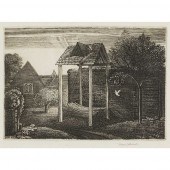 § GRAHAM SUTHERLAND O.M. (BRITISH
§ GRAHAM SUTHERLAND O.M. (BRITISH 1903-1980) MAY GREEN, 1927 (TASSI 24) Etching, signed in pencil to margin11cm (4 1/4in), 16cm (6 1/4in)Provenance: Christie's, South Kensington, 16th April 2014, lot 121.Literature: Roberto Tassi and Edward Quinn, Graham Sutherland: Complete Graphic Work, London 1988, no.24.Gordon Cooke, Graham Sutherland: Early Etchings, London 1993, no.16.Graham Sutherland specialised in etching whilst a student at London University’s Goldsmith’s College School of Art between 1921 and 1926. He was taught by Malcolm Osborne and Stanley Anderson and trained alongside Paul Drury and William Larkins. It was during this formative period that he made the following group of etchings, with May Green created in 1927; all of them reveal his precocious and emerging talent. Indeed, Sutherland established his professional standing as a printmaker and held his first solo exhibition in 1924, at the Twenty-One Gallery in London. The following year he was elected an Associate Member of the Royal Society of Painter-Etchers and Engraves. Shortly after graduating, he was appointed to the staff of Chelsea College of Art, where he taught engraving until 1932.In 1924, Larkins found an impression of The Herdman’s Cottage etching of 1850 by the visionary artist Samuel Palmer (1805-81) in a shop on the Charing Cross Road and showed it to his fellow students. Sutherland recalled the impact it had on him: ‘I remember that I was amazed at its completeness, both emotional and technical. It was unheard of at the school to cover the plate almost completely with work and quite new to us that the complex variety of the multiplicity of lines could form a tone of such luminosity…As we became familiar with Palmer’s later etchings, we ‘bit’ our plates deeper. We had always been warned against ‘overbiting’. But we did ‘overbite’ and we ‘burnished’ our way through innumerable ‘states’ quite unrepentant at the way we punished and maltreated the copper…It seemed to me wonderful that a strong emotion, such as was Palmer’s, could change and transform the appearance of things.’ (1)Palmer’s reputation had diminished since his death in 1881, but was resurrected when an exhibition of his work was mounted at the Victoria and Albert Museum in London in 1926. As illustrated in the current group, Roberto Tassi has explained that Palmer’s influence on Sutherland’s etchings showed ‘in the presence of the sun and its light shining through the trees, the starry sky streaked with horizontal clouds, the contrast between the evening dusk that is already creeping over the land in thickening shadows and the soaring beams of the setting sun.’ (2)Sutherland engaged with and extended the English pastoral tradition and its idealism, with Gordon Cooke proclaiming: ‘Prints such as Village, Pecken Wood, Cray Fields, St Mary Hatch, Lammas and May Green concern the unchanging experience of life in the countryside, the generations which have worked in it and lived from it and the manner in which nature rules such a way of life.’ (3) Yet Sutherland’s etched images of the mid-1920s are also laced with nostalgia - as rural communities changed - and with an embracing of religion which culminated in his acceptance into the Roman Catholic church in 1926.Tassi continues: ‘Throughout this period, the influence of Palmer continues, most noticeably in the atmosphere, which seems to be suspended, wrapped in mystery and a tinge of mysticism. The sun, the doves, the stars, the birds and the sheep all become religious symbols; the air is one of enchantment; the contrast between light and shade, though violent, is not disturbing, but seems rather to diffuse an air or quietude over the world. In general, however, the feeling is one of abstraction rather than life.’ (4)Sutherland’s success as an etcher came to an abrupt end with the collapse of the art market following the Wall Street crash of 1929. He turned to painting, but returned to print-making at various points during his career, including lithography in the 1940s and 1950s before a resumption of etching in the 1970s.(1) As quoted in Ronald Alley, Graham Sutherland, London, 1982, p 9.(2) Roberto Tassi and Edward Quinn, Graham Sutherland: Complete Graphic Work, London 1978, p.19(3) Gordon Cooke, Graham Sutherland: Early Etchings, London 1993, unpaginated(4) Tassi op.cit., p.20Note: According to Gordon Cooke, this was the only etching which Sutherland made in 1927 (op.cit, unpaginated). He has also explained that it is the last in a series of four etchings, including Cray Fields and St Mary Hatch, ‘which seem to celebrate both religious and rural values, anchoring the scenes to the calendar and particular places.’
§ GRAHAM SUTHERLAND O.M. (BRITISH
§ GRAHAM SUTHERLAND O.M. (BRITISH 1903-1980) MAY GREEN, 1927 (TASSI 24) Etching, signed in pencil to margin11cm (4 1/4in), 16cm (6 1/4in)Provenance: Christie's, South Kensington, 16th April 2014, lot 121.Literature: Roberto Tassi and Edward Quinn, Graham Sutherland: Complete Graphic Work, London 1988, no.24.Gordon Cooke, Graham Sutherland: Early Etchings, London 1993, no.16.Graham Sutherland specialised in etching whilst a student at London University’s Goldsmith’s College School of Art between 1921 and 1926. He was taught by Malcolm Osborne and Stanley Anderson and trained alongside Paul Drury and William Larkins. It was during this formative period that he made the following group of etchings, with May Green created in 1927; all of them reveal his precocious and emerging talent. Indeed, Sutherland established his professional standing as a printmaker and held his first solo exhibition in 1924, at the Twenty-One Gallery in London. The following year he was elected an Associate Member of the Royal Society of Painter-Etchers and Engraves. Shortly after graduating, he was appointed to the staff of Chelsea College of Art, where he taught engraving until 1932.In 1924, Larkins found an impression of The Herdman’s Cottage etching of 1850 by the visionary artist Samuel Palmer (1805-81) in a shop on the Charing Cross Road and showed it to his fellow students. Sutherland recalled the impact it had on him: ‘I remember that I was amazed at its completeness, both emotional and technical. It was unheard of at the school to cover the plate almost completely with work and quite new to us that the complex variety of the multiplicity of lines could form a tone of such luminosity…As we became familiar with Palmer’s later etchings, we ‘bit’ our plates deeper. We had always been warned against ‘overbiting’. But we did ‘overbite’ and we ‘burnished’ our way through innumerable ‘states’ quite unrepentant at the way we punished and maltreated the copper…It seemed to me wonderful that a strong emotion, such as was Palmer’s, could change and transform the appearance of things.’ (1)Palmer’s reputation had diminished since his death in 1881, but was resurrected when an exhibition of his work was mounted at the Victoria and Albert Museum in London in 1926. As illustrated in the current group, Roberto Tassi has explained that Palmer’s influence on Sutherland’s etchings showed ‘in the presence of the sun and its light shining through the trees, the starry sky streaked with horizontal clouds, the contrast between the evening dusk that is already creeping over the land in thickening shadows and the soaring beams of the setting sun.’ (2)Sutherland engaged with and extended the English pastoral tradition and its idealism, with Gordon Cooke proclaiming: ‘Prints such as Village, Pecken Wood, Cray Fields, St Mary Hatch, Lammas and May Green concern the unchanging experience of life in the countryside, the generations which have worked in it and lived from it and the manner in which nature rules such a way of life.’ (3) Yet Sutherland’s etched images of the mid-1920s are also laced with nostalgia - as rural communities changed - and with an embracing of religion which culminated in his acceptance into the Roman Catholic church in 1926.Tassi continues: ‘Throughout this period, the influence of Palmer continues, most noticeably in the atmosphere, which seems to be suspended, wrapped in mystery and a tinge of mysticism. The sun, the doves, the stars, the birds and the sheep all become religious symbols; the air is one of enchantment; the contrast between light and shade, though violent, is not disturbing, but seems rather to diffuse an air or quietude over the world. In general, however, the feeling is one of abstraction rather than life.’ (4)Sutherland’s success as an etcher came to an abrupt end with the collapse of the art market following the Wall Street crash of 1929. He turned to painting, but returned to print-making at various points during his career, including lithography in the 1940s and 1950s before a resumption of etching in the 1970s.(1) As quoted in Ronald Alley, Graham Sutherland, London, 1982, p 9.(2) Roberto Tassi and Edward Quinn, Graham Sutherland: Complete Graphic Work, London 1978, p.19(3) Gordon Cooke, Graham Sutherland: Early Etchings, London 1993, unpaginated(4) Tassi op.cit., p.20Note: According to Gordon Cooke, this was the only etching which Sutherland made in 1927 (op.cit, unpaginated). He has also explained that it is the last in a series of four etchings, including Cray Fields and St Mary Hatch, ‘which seem to celebrate both religious and rural values, anchoring the scenes to the calendar and particular places.’ -
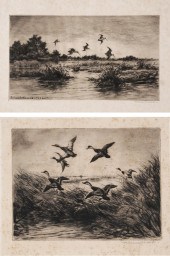 Roland Hamner Clark (New York,
Roland Hamner Clark (New York, 1874-1957) Two drypoint engravings signed lower right "Roland Clark" and inscribed with title in bottom margin: Scatter!, edition 75, 5-1/8 x 6-3/4 in. (plate), 8-3/4 x 11-1/8 in. (page), tape stains; Snip
Roland Hamner Clark (New York,
Roland Hamner Clark (New York, 1874-1957) Two drypoint engravings signed lower right "Roland Clark" and inscribed with title in bottom margin: Scatter!, edition 75, 5-1/8 x 6-3/4 in. (plate), 8-3/4 x 11-1/8 in. (page), tape stains; Snip -
 2 RICHARD CLARKE, TN, ABSTRACT
2 RICHARD CLARKE, TN, ABSTRACT WATERCOLORSTwo Richard Clark (Tennessee, 1923-1997) watercolors. Item 1: Abstract watercolor on paper, titled en verso "Ghost Stone", signed and dated lower left, "Clarke 63". Image: 17 1/8" H x 22 1/8" W, silver metal frame: 25 1/4" H x 29 1/4" W. Item 2: Abstract watercolor on paper, titled en verso "Wind, Land, Sky", signed and dated lower right, "Clarke 64". Sight: 18" H x 23" W, Silver metal frame: 25 1/4" H x 29 1/4" W. Biography: Richard Clarke was one of the early members of the University of Tennessee's art faculty. He is often associated with the "Knoxville Seven", a group of progressive artists connected to the University of Tennessee which included Robert Birdwell, C. Kermit Ewing, Joanna Higgs, Walter H. Stevens and Carl Sublett. He often found inspiration for his watercolor abstractions in the natural world around him. Note: Proceeds to benefit the Knoxville Symphony Orchestra. Condition: Both items: Excellent condition. Minor abrasions to frame.
2 RICHARD CLARKE, TN, ABSTRACT
2 RICHARD CLARKE, TN, ABSTRACT WATERCOLORSTwo Richard Clark (Tennessee, 1923-1997) watercolors. Item 1: Abstract watercolor on paper, titled en verso "Ghost Stone", signed and dated lower left, "Clarke 63". Image: 17 1/8" H x 22 1/8" W, silver metal frame: 25 1/4" H x 29 1/4" W. Item 2: Abstract watercolor on paper, titled en verso "Wind, Land, Sky", signed and dated lower right, "Clarke 64". Sight: 18" H x 23" W, Silver metal frame: 25 1/4" H x 29 1/4" W. Biography: Richard Clarke was one of the early members of the University of Tennessee's art faculty. He is often associated with the "Knoxville Seven", a group of progressive artists connected to the University of Tennessee which included Robert Birdwell, C. Kermit Ewing, Joanna Higgs, Walter H. Stevens and Carl Sublett. He often found inspiration for his watercolor abstractions in the natural world around him. Note: Proceeds to benefit the Knoxville Symphony Orchestra. Condition: Both items: Excellent condition. Minor abrasions to frame. -
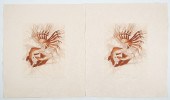 GUILLAUME AZOULAY. "HAMILTON
GUILLAUME AZOULAY. "HAMILTON ENCORE," ETCHINGS Etchings, each pencil signed, sheet sizes: 26 1/4 x 22 in., unframed.
GUILLAUME AZOULAY. "HAMILTON
GUILLAUME AZOULAY. "HAMILTON ENCORE," ETCHINGS Etchings, each pencil signed, sheet sizes: 26 1/4 x 22 in., unframed.
...many more examples with full details are available to our members - Learn more

